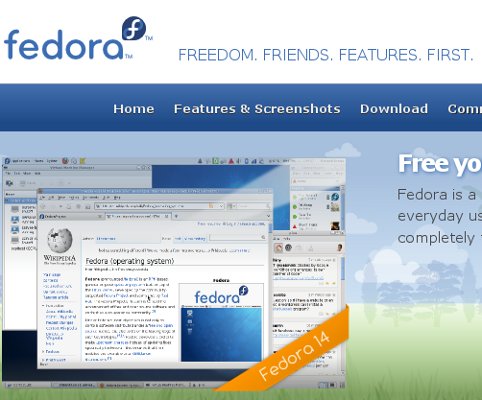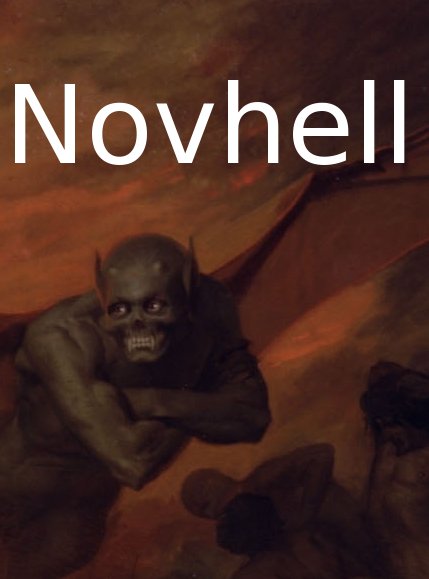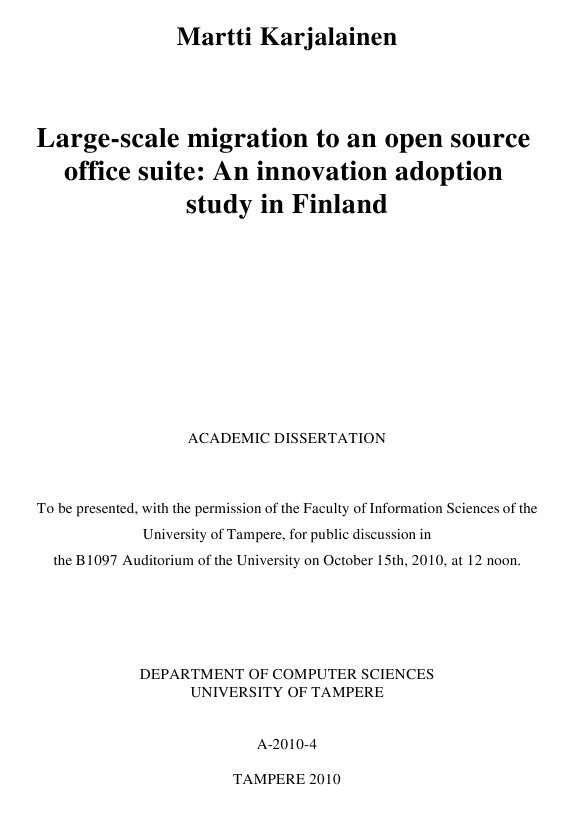11.10.10
Posted in GNU/Linux, Novell, OpenSUSE at 2:38 pm by Dr. Roy Schestowitz

Summary: Another key person of OpenSUSE has decided to leave Novell
EARLIER today we wrote about the bad shape that Novell was in amid sale negotiations. Now it’s confirmed that Michael Löffler from OpenSUSE is leaving Novell.
As he puts it in a seemingly informal post, “after 7 years with SUSE and Novell I’ve chosen to change something in my life – and decided to accept a new job and will lay down my duties in the openSUSE project.”
Löffler returns to familiar territories and we wish him luck. “Just to stop any rumours,” he clarifies, “I leave Novell because I found a new job in the trade show management area close to Nuremberg.”
OpenSUSE has been having stormy conditions with that recent delay and other issues which Novell does not address as it’s closing down (in the development sense, i.e. going more proprietary). █
Permalink
 Send this to a friend
Send this to a friend
Posted in GNU/Linux, Kernel at 4:56 am by Dr. Roy Schestowitz

Summary: A quick word about the suggestions that Linux is “proprietary”, which helps some FUD-Meisters
Without delving into the specifics and the hyperlinks (deliberately omitted), there’s a debate right now about whether Linux is Free software or proprietary (or both). It is probably not the best question to ask. Linux — like Android — enables many people to move from a world that is purely proprietary into a world where freedom is favoured and companies adapt gradually, eventually realising that by making their program code (e.g. drivers) publicly available they get a lot of ‘free’ bug fixes and improved stability. This is true not just in Linux but in other layers of the system, even hardware. So, Techrights will not get involved in the counter-productive debate which at the moment just feeds enemies of freedom (they use Linux as ‘proof’ that free/open source software cannot succeed). Even the FSF learned to abstain from talking about it like that. █
“Today many people are switching to free software for purely practical reasons. That is good, as far as it goes, but that isn’t all we need to do! Attracting users to free software is not the whole job, just the first step.”
–Richard Stallman
Permalink
 Send this to a friend
Send this to a friend
Posted in GNU/Linux, KDE at 4:44 am by Dr. Roy Schestowitz

Summary: Quick endorsement of Fedora 14 and KDE 4.5.x
YESTERDAY there were almost no posts at all. The reason is, well… I was setting up a new machine that had arrived with Windows on it. Obviously I just wiped Windows and installed the latest Fedora 14 with KDE desktop. I am sorry to say that I have not found a single bug yet. Any person who looks for something that works brilliantly out of the box and is easy to use should take a look at the KDE spin of Fedora 14. I have not had a chance to test the main ISO, which is GNOME based. I downloaded it but did not burn it. Either way, I am sticking with Fedora and the least I can do is recommend it to other people. The KDE team also deserves praises for excellent work it did to deliver 4.5.x, which is polished. Another user of Fedora with KDE is Pamela Jones from Groklaw. █
Permalink
 Send this to a friend
Send this to a friend
Posted in GNU/Linux at 4:32 am by Dr. Roy Schestowitz

Summary: Novell is a company where people come to end their career and we show this by going through two weeks of Novell news and demonstrating relative idleness
IT is quite shocking how little news there has been from/about Novell in recent weeks (and there was lots more four years ago, not just months ago). It’s like the company died and therefore it’s hard to find anything clueful to write about it. It has been about a fortnight since our last post about Novell’s progress, so here is yet another which is very concise unless and except in places where there is something worth adding.
SCO
Groklaw has kept track of SCO vs Novell and at the end of last month it posted an update:
Here it is, Novell’s appeal brief in SCO v. Novell. It’s responsive to SCO’s earlier filing, which you can find in our permanent Novell Appeals page.
Stock
Novell mostly appears in some news in the context of finance. Here are the headlines we have found of articles that mention NOVL (about 50% of all the items Google News has picked for “novell”):
- Bearish Pressure Building on Novell Inc.; NOVL
- Noticeable Active Stocks at NASDAQ are JBLU, AMAT, MRVL, NOVL
- Bullish Movements at NASDAQ Technology Sector from PSL are NOVL, CPWR, CDNS, FLEX and AMKR
- Deep Dive Into Today’s Block Trading Activity for Novell
- Shares of VMware Rank the Highest in terms of Relative Performance in the Systems Software Industry (VMW, N, NOVL, CHKP, ORCL)
- Shares of VMware Rank the Highest in terms of Relative Performance in the Systems Software Industry (VMW, N, NOVL, CHKP, ORCL)
- A Closer Look at Today’s Block Activity for Novell
- Noticeable Falls at NASDAQ are NOVL, STX, AMLN, CRUS
- Should You Sell Novell Today?
- Preparing for Symantec’s Earnings Announcement; SYMC, CHKP, MFE, NOVL
- Setting the Stage for McAfee’s Earnings Announcement; MFE, SYMC, CHKP, NOVL
- Novell has a Relatively Low Future Earnings Growth in the Systems Software Industry (NOVL, TSYS, CA, BMC, CHKP)
- Novell Block Volume Alert
- Tech/Comm Acquisition Target Updates (CSCO, BRCD, NOVL, PGI, STX, WDC, XLK)
- NOVELL HAS A RELATIVELY LOW FUTURE EARNINGS GROWTH IN THE SYSTEMS SOFTWARE INDUSTRY (NOVL, TSYS, CA, BMC, CHKP)
- Technical Analysis Alert for Novell (NOVL)
- SHARES OF NOVELL ARE MOVING HIGHER ON 1.1X ABOVE-AVERAGE VOLUME (NOVL)
- Bearish Movements at NASDAQ Technology Sector from PSL are PMCS, CHIO, IDTI, NOVL and JASO
- Block Trading Highlights for Novell
- Volume Gainers at NASDAQ Technology Sector from PSL are NOVL, ATML, JASO, ONNN and CDNS
- Volume Gainers at NASDAQ Technology Sector from PSL are NOVL, ATML, JASO, ONNN and CDNS
- Block Volume Update for Novell (NOVL)
- Noticeable Active Stocks at NASDAQ Technology Sector are (BRCD, NOVL, LSCC … – Wall Street Bay
- Shares of Novell (NOVL) Remain Above the Support Line
- Novell Block Volume Review
- TradingMarkets 7 Stocks You Need to Know for Tuesday: BP, MA, V, WYNN, FSLR, ADSK, GRMN
- Surging Volumes at NASDAQ Technology Sector from PSL are ENTR, PMCS, NOVL, XING and CNXT
- Block Volume Review for Novell
- Bearish Trading Activity for Novell
- Research on McAfee and Novell — Security and Services Take to the Clouds
- Block Trading Analysis for Novell
- Check Point Software Technologies Ltd. Attracting Bullish Investors; CHKP, SYMC, NOVL
- Block Trading Analytics for Novell
- 52-WEEK HIGH REMAINS ON THE HORIZON FOR NOVELL (NOVL, VDSI, VMW, SYMC, WBSN)
- 52-WEEK HIGH REMAINS ON THE HORIZON FOR NOVELL (NOVL, VDSI, VMW, SYMC, WBSN)
- Novell to Report Fourth Fiscal Quarter and Full Fiscal Year 2010 Results
In the links above, that last one is a reminder that the quarterly results come out next month.
GroupWise
GroupWise no longer appears in the news all that much. But Novell’s PR people try to change that and there are still some mentionings of the product (GroupWise is entirely proprietary), sometimes in the context of GWAVA and GWAVACon. That latter one is about Colleen O’Keefe and she is also mentioned here.
From IDG (also in this domain) we learn that: “Unfortunately, BES Express is still unavailable for Novell (NOVL) GroupWise and other corporate mail servers.”
This new item says: “These and other enterprises are benefiting from Cloud Sherpas expertise migrating users from on-premise platforms-like Microsoft Exchange, IBM Lotus Notes and Novell GroupWise-to the cloud with Google.”
GroupWise is mentioned in relation to Adium 1.4 and Nelson Mandela Bay Metro:
The fact that M+Archive was designed to seamlessly integrate with the municipality’s Novell GroupWise system was also essential.
GroupWise is additionally mentioned in yet another one of Messaging Architects’ new press releases (also here) and TechRepublic has published “Five tips for successfully migrating from GroupWise to Exchange 2010″ (TechRepublic is quite a Microsoft booster in general).
GroupWise made it into this article on mobile phone platforms and New Zealand’s Prime Minister office:
Our servers are a range of Microsoft and Novell. The reasoning behind the Novell environment is that Government has predominately been a Novell client and DPMC has for that reason retained its Groupwise email system. DPMC is extremely reliant on its use of email, so having Groupwise gives us the resilience and availability we require, and its support requirements are considerably lower than [Microsoft] Exchange. There is also the aspect of security of emails that has kept us with Groupwise.
GroupWise is supposed to add some Pulse functionality (the plan is not yet entirely known, especially after Google dumped Wave) and TechWeb, which Novell is paying (Novell is a sponsor), has just published not one but two articles that mention Novell’s Pulse (David Berlind’s article calls Pulse “island of technology” though):
i. Enterprise 2.0 Preview: Collaboration’s Next ‘Wave’
Novell is forging ahead with the development of Pulse, a real-time enterprise communication and collaboration platform that relies on Wave’s federation protocol. Announced a year ago, Pulse was made available to a limited number of users as a preview starting in March. The company won’t say exactly what it plans to announce at the Enterprise 2.0 Conference, but chances are it will have something to do with wider availability.
ii. Twitter-Like Activity Streams: The New Center Of Gravity For The Social Enterprise
Philosophically, Novell is the closest to having the right vision. It’s just that it may have placed its bet on the wrong horse. At the last E2, Novell demonstrated how, using Google’s open Wave Federation Protocol (WFP), the same activity stream could be hosted in both Novell’s Pulse and Google’s Wave. The idea being that if you picked Google’s Wave as your company’s activity stream host of choice and your ad agency picked Novell’s Pulse as its activity stream host of choice, neither of you would have to compromise. Both of you could have visibility into the same events. But despite its open source nature, WFP is by no means a standard. Not only don’t any other activity stream hosts or “event providers” support it, Google discontinued development on Google Wave itself earlier this year. Theoretically, work on WFP can carry on. But so far, there’s been no rallying cry from the industry to get behind it. For all its good intentions, even Novell’s Pulse is an island of technology.
Here is another news article which mentions Novell’s Pulse:
But “people are going to use social tools for business whether the tools are provided by IT or not,” warned Wendy Steinle, marketing director for Novell Pulse. Yes, for business and for pleasure, the Twitter tweets and Facebook posts still fly from phones and computers all the day long, no matter what an employer has to say about the matter. Sure, a company can give an offending tweeter the boot but that’s a bit like locking the house after the burglar leaves with all your stuff. Sadder still if the offending post breaks compliance and the lawman locks you up for the burglary.
People
“If you’re the coach, you must know all the players” is a post on a subject we mentioned about two weeks ago and Novell’s PR does too. It’s an advertisement, but the statement in the headline goes a long way. In order to understand Novell’s impact one must also see where its former managers go.
Patrick from Novell becomes CEO of Apperian:
Prior to xkoto, which was acquired by Teradata, Patrick was vice president and general manager at Novell Inc., where he managed the SUSE Linux and Netware operating system lines. He joined Novell in 2003, as part of the acquisition of Ximian, where he was president and CEO. He also served in senior roles with The Learning Company, Mattel, WordStar, Sun Microsystems, Ashton-Tate and Lotus.
Yves Michali is another former Noveller who entered a new company:
Additionally, the company also announced its board of directors, which includes Yves Michali (formerly of Novell, Microsoft, Mobiclick, and Groove Network), Yvan Morel de Westgaver (formerly an executive at EDS), and Bart Luyten, general partner at BAMS Angel Fund.
Gordon Jones, Novell’s former CIO, becomes CTO of Infogroup:
He has also worked as CIO for Novell (1990 – 1995), Franklin Templeton (1995 – 1999), Beyond.com (1999 – 2000), ToysRUs.com (2000 – 2001), eBay and formerly Wells Fargo subsidiary, BillPoint (2001 – 2003).
Campus
The Provo-based Novell campus is mentioned for the following reason:
The Utah Valley Entrepreneurial Forum (UVEF) will induct Hal Wing of Wing Enterprises into its UVEF Hall of Fame tonight at the Provo Novell Campus. Inductees represent individuals and organizations with an enduring legacy of entrepreneurial excellence.
A scrap yard is also coming nearer to Novell, just not to shred the company.
Now, through a series of agreements with Provo city, UTA and others, this 2 1/2-acre scrap metal yard will be moving to a 53-acre property at 1776 S. Colorado Ave. (East of Novell) and into a new state-of-the-art recycling center.
Novell could use some recycling. The company itself needs to be recycled.
Identity Manager 4
The news about Identity Manager 4 is no longer news (it’s about a month old), but some sites were spreading the news late and covered IDM at Novell (it’s a proprietary software business).
In addition to minor mentions Novell got this belated coverage from Adrian Bridgwater:
The company specifies that its new product will simplify the identity management provisioning process and deliver a consistent framework for managing identities across physical, virtual, and cloud environments.
Self Praise
In a self-promotional press release, Novell mentioned that so-called ‘magic’ quadrant from Gartner, which is a corruptible analyst that one needs to pay to receive some good words. From the opening paragraph:
Novell today announced it has been positioned by Gartner, Inc. in the Leaders Quadrant of the Magic Quadrant for User Provisioning.* Covering vendors and solutions that manage identities across systems and applications, the Gartner report cites compliance as the main driver for uptake of products.
The thing about those ‘prizes’ though, is that they’re open to abuse and this one too is potentially a new example:
Trend Micro swept the Product Innovation category of Network Security Software, beating out nearest competitors Novell and Websense.
Who judges this and how?
Intelligent Workload and Other Marketing Fluff
Novell has made almost nothing out of PlateSpin, which it spent hundreds of millions of dollars on. PlateSpin’s sale to Novell is mentioned in the Canadian press again;
This fund, which is closed to new investors, has outperformed its peers largely because of a fortuitous investment in software maker PlateSpin Ltd., which was bought in 2008 by Novell Inc. “That is the fundamental holding which drove the returns,” said Scott Clark, managing director of Covington Capital Corp.
A lot of PlateSpin’s main people have left Novell since then and Novell’s Intelligent Workload Management or more of a rebrand. It managed to get some press, especially from Vodacom at the moment. The latter article says: “By using Novell’s WorkloadIQ solutions, Vodacom Business services can support a customer’s IT environment through workload migration, virtual and physical data replication and protection to achieve a scalable cloud.”
It is the same here. Proprietary software from Novell finds some way to have itself promoted. Usually Novell is just mentioned in a long list of vendors with an offer in virtualisation (some additional examples omitted from this post) and here is an example of how these things go:
CED Solutions is a Microsoft CPLS, Certified Partner for Learning Solutions; Cisco Learning Partner Associate; EC Council, Novell, SCA, and training partner with many other vendors.
Another new example:
Storage software provider Novell had also launched Novell Cloud Manager, an umbrella operating system that controls virtualized operating systems working on multiple hypervisors. It currently supports hypervisors including VMware vSphere, Microsoft Hyper-V and open source Xen operating systems, SUSE Linux Enterprise Server, Microsoft Windows server and Red Hat Enterpries.
It’s common to find Novell listed like this. Not many articles are written just about Novell anymore. Here is IDG giving away exam details for “Novell Certified Linux Administrator”. It is more of a content dump from IDG, it’s not journalism at all.
Marketing fluff (e.g. “Clouds over Manhattan”) is the main thing that keeps Novell in some news while the management arranges the sale of their company. Over in YouTube there are over a dozen videos like [1, 2] from account Novell ChalkTalks, which we never saw before by the way. It’s probably another account held by Novell.
Another new video from novacoast on Novell File Management Suite has been uploaded, as well as a couple from account Novell Labs, which speaks about Fog Computing in a box. They call it “Microburst” [1, 2].
There is another upload of Novell’s Justin Steinman sucking up to IBM and a video with the new Teaming 3.0 UI
Here is a post about IBM adopting SUSE Linux Enterprise for WebSphere Appliances. Only Novell’s PR people seem to be covering this:
In the next installment of our Novell partner podcast series, Liz Padula, senior marketing manager at Novell, talks with Marc Haberkorn, product manager in the WebSphere team at IBM, about how IBM is working with Novell to deliver a portfolio of software appliances across many of its brands, including WebSphere, powered by SUSE Linux Enterprise.
Novell has also just put out this press release to tell people that SLE* is not dead. It’s just probably on its way to VMware, along with OpenSUSE which has new/interim leaders interviewed. Novell is not a good place to be right now, definitely not when it comes to job security. GNU/Linux and SUSE are not going away because they are GPL-licensed, but what will keep SUSE safe from competition? Here is one new article about Teradata:
The cluster runs Novell’s SUSE Linux Enterprise Server 10, the Teradata 13.10 database, and has a management console that runs on Microsoft’s Windows Server 2003. This DMA 560 machine is being positioned not only as an entry data mart box, but also as a BI application test and development machine.
It’s important to remember that the future of Novell is quite orthogonal to the future of GNU/Linux because the code will live on and companies like Teradata do not rely on SLE* as they can use RHEL too. To say negative things about Novell is by all means not to harm GNU/Linux; Rather, it’s to defend GNU/Linux from Microsoft patent tax. █
Permalink
 Send this to a friend
Send this to a friend
Posted in Hardware, Marketing, Microsoft at 2:41 am by Dr. Roy Schestowitz

Summary: Microsoft’s actions suggest that it is losing a lot of money on KINect, so there is no guarantee that the project will exist for a long time to come
M
ICROSOFT advertises KINect like advertising budget restraints have been abolished. According to a source we cited recently, close to half a billion dollars are spent just marketing this thing, which is not even in the hands of many people yet (will it ever?). We talk about it a lot in our show, TechBytes, especially because Tim — an Xbox 360 owner — keeps track of the product and ridicules the KINect in his blog this week:
I think you will be the guinea pigs and we will be reading about issues you have with the device in the coming months.
When/if one cancels out all the marketing noise, it becomes evidence that KINect has many problems which we covered in posts such as:
“Hacker unshackles Kinect from Xbox,” The Register is reporting:
An amateur hacker claims to have freed Microsoft’s Kinect from the Xbox, a feat that allows him to control the the just-released motion-tracking game device from his Windows PC.
The claim was documented in two videos released over the weekend by a member of the Natural User Interface Group. In one, Kinect’s motorized-tilt is shown being controlled with the moveup and movedown buttons of his Windows 7 PC. Normally, the movements can only be tracked when Kinect is connected to an Xbox 360 game console.
A second video shows the Kinect outputting color and depth data to the hacker’s PC.
By themselves, the videos don’t prove that the Kinect has been completely rooted, but they suggest that the NUI Group member AlexP is well on his way. The videos surfaced a few days after Adafruit Industries, a seller of DIY electronics kits, offered a $2,000 bounty to the first person who published open-source drivers for the Kinect.
There is a debate over whether Microsoft makes money from KINect or just gives it away with subsidy, thus incurring a financial loss. Either way, only time will tell if KINect too will end up in the pile of dead products from Microsoft. In the past 3 years Microsoft has killed nearly 60 products (those which we documented anyway) and even Apple is starting to kill some of its products. Here is what Pogson said about Apple exiting the servers market:
The first Apple server I saw was a box on the doorstep of the school left during Christmas Break. I was not in charge of receiving parcels so I put it inside and left it there. I went in and found we had not Internet access. The fools at Head Office sent us an e-mail, during Christmas Break. I struggled to find what was wrong locally. Everything seemed fine. Finally, I phoned Head Office and was informed that the box contained our new router which Head Office was allowing to connect to the WAN and no others… Sigh. I reminded them about Christmas Break… “Oh!” the voice said… Anyway, I plugged in that server and had DHCP and a route once again. That was the year I first installed GNU/Linux on top of that other OS. I have had a stomache-churning response to seeing Apple servers ever since. Fortunately there are not many out there. Now there will be fewer over time. Too bad I will retire soon. The world is becoming a better place.
Marketing is not enough for success. It can help create initial hype (like KINect’s and Silverlight’s, or most famously Vista with the “show us your wow” campaign), but if the products fail in practice (Xbox 360 RRoD for example) then it’s all doomed to fail sooner or later. Marketing is deception and it’s a short-term investment because people cannot be deceived indefinitely. █
Permalink
 Send this to a friend
Send this to a friend
Posted in Europe, Microsoft, Office Suites, Open XML, OpenDocument, OpenOffice at 2:13 am by Dr. Roy Schestowitz

Summary: Finland’s story of migrations to OpenOffice.org is told in a comprehensive formal document; Romania goes the other way and ISO continues to show why it is severely flawed
Tampere University has just released this 234-page thesis whose PDF version has been downloaded nearly 700 times and whose abstract reads as follows:
This study investigates the largest transition in Finland to an open source office suite and to an open standard for office documents. The IT environment of the open source OpenOffice.org migration involves more than 10 000 workstations in the Finnish Ministry of Justice and its administrative sector.
Methodologically, the research is a longitudinal innovation adoption study covering the 7-year time span from 2003 to 2010. The study applies and tests the organizational innovation adoption process model originally developed by Everett Rogers. In addition to the theory-testing approach, the study includes artifact-building and artifact-evaluation activities of design research. The research view of the study introduces a participatory researcher’s implementation perspective where the researcher as a staff member of the organization has been in charge of the adoption of the innovation in the organization.
The findings of the study provide contributions both to IS research and practice. The events of the study give reason to suggest that the characteristics of the open source software with low-cost licenses call for improvements in the organizational innovation adoption stage model. The findings suggest that the predefined order of stages in the innovation process and sharp distinctions between stages should not be expected in organizational innovation adoption. As a new model and method, the study provides a complementary framework for the instrumentation and documentation of the open source innovation process in the organizational context. The study confirms several results from previous research and practice, especially the importance of top management support, systematic open source skill building and the presence of innovation champions in the adoption of open source solutions.
For IS practice, the study shows that the transition to an open source office suite is feasible in a large-scale context and that substantial benefits can be achieved as the result of the transition. For the user organizations of open source software, lower cost has been the most commonly cited benefit and one of the main reasons for adopting open source. Other often cited considerations include strategic goals like the facilitation of more sovereign IT governance and the reduction of vendor dependence through open source solutions and open standards. The study addresses several practically important issues involved in the adoption of open source, e.g., the analysis of software functionality and interoperability, cost evaluations, installation and configuration issues, local language support issues, additional tools to support the migration, user training and support, technical support, and software usage measurements. The evaluation of costs in the study indicates that the migration to the open source office suite platform will benefit the target organization of the study with impressive cost savings when compared to the deployment of a comparative proprietary office suite platform. The study applies numerous best practice approaches which together with the rich insight provided by the research should benefit other organizations considering open source office suite adoptions both from the perspectives of management and implementation.
As summarised by Arjen Kamphuis:
Phd thesis on succesful migration to #openoffice by Finnish gov.
For some background about Finland also consider reading:
One would expect Finland to be ahead when it comes to Free software, at the very least because it’s the country Linux came from. In Romania, which some people have just told us is known for higher corruption rates, Microsoft manages to reign, still. One Romanian reader messaged us yesterday to say that: “While EU is abandoning proprietary software, Romanian civil servants learn to use MS Office http://tinyurl.com/33j8xwk (Google Translate)”
For more information about the situation in Romania see:
A few of the links above (especially the last two) speak about how Microsoft seemingly corrupted the vote on OOXML in Romania. In turn it forces a lot of the population to buy Microsoft Office or be called “pirate”.
Finland’s migration to OpenOffice.org is not unique. There are other countries that do the same thing, Malaysia for example. The important thing is that parts of the Finnish government will be able to exchange information with the public in ODF format. OOXML (and other Microsoft Office formats) is proprietary, so no government should ever use/require it, thereby imposing the purchase of a particular set of products from one single company with dubious history.
Speaking of OOXML, it turned ISO into a launching stock and it seems to be happening again. Andy Updegrove writes:
After sixteen years of working in parallel to the traditional standards infrastructure, the World Wide Web Consortium has taken an interesting decision: to begin submitting selected W3C Recommendations to that same system for endorsement. In doing so, it joins the small handful of consortia (seven, to be exact) that have applied for this option out of the hundreds of consortia currently active in the information and communications (ICT) to apply for that option.
If this process sounds vaguely familiar, that’s likely because this is the same process that OASIS used to gain global endorsement of its OpenDocument Format (ODF). Microsoft took a similar, but procedurally distinct, route with OOXML, its competing document format, when it offered it to ECMA, which enjoys a special “Fast Track” relationship with JTC1. What won’t sound familiar is the conditions that the W3C has successfully included in its application to make submissions, on which more below.
It was only last week that W3C was involved in a separate controversy because of Microsoft. Glyn Moody links to this article about W3C becoming an official submitter to ISO and adds: “not sure this is good: wouldn’t it be better to ignore ISO after OOXML?” █
Permalink
 Send this to a friend
Send this to a friend
























 Content is available under CC-BY-SA
Content is available under CC-BY-SA